Configuración y reclamación de Nexus independiente para la conectividad entre puntos de vista
Opciones de descarga
Lenguaje no discriminatorio
El conjunto de documentos para este producto aspira al uso de un lenguaje no discriminatorio. A los fines de esta documentación, "no discriminatorio" se refiere al lenguaje que no implica discriminación por motivos de edad, discapacidad, género, identidad de raza, identidad étnica, orientación sexual, nivel socioeconómico e interseccionalidad. Puede haber excepciones en la documentación debido al lenguaje que se encuentra ya en las interfaces de usuario del software del producto, el lenguaje utilizado en función de la documentación de la RFP o el lenguaje utilizado por un producto de terceros al que se hace referencia. Obtenga más información sobre cómo Cisco utiliza el lenguaje inclusivo.
Acerca de esta traducción
Cisco ha traducido este documento combinando la traducción automática y los recursos humanos a fin de ofrecer a nuestros usuarios en todo el mundo contenido en su propio idioma. Tenga en cuenta que incluso la mejor traducción automática podría no ser tan precisa como la proporcionada por un traductor profesional. Cisco Systems, Inc. no asume ninguna responsabilidad por la precisión de estas traducciones y recomienda remitirse siempre al documento original escrito en inglés (insertar vínculo URL).
Contenido
Introducción
En este documento se describen los pasos necesarios para habilitar y solicitar switches Nexus independientes en Intersight para mejorar la compatibilidad con Cisco TAC.
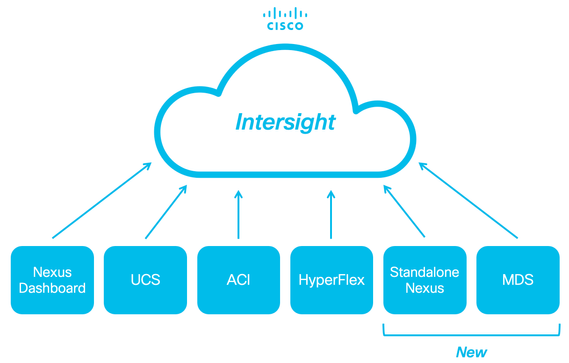
Prerequisites
Debe tener una cuenta en Intersight.com, no se necesita licencia para realizar solicitudes de Cisco NX-OS®. Si necesita crear una nueva cuenta de Intersight, consulte Creación de cuenta.
Requirements
Cisco recomienda que tenga conocimiento sobre estos temas:
En el switch Nexus independiente, NXDC tiene estas directrices y limitaciones:
- Cisco NX-OS debe ejecutar la versión 10.2(3)F o posterior
- DNS se debe configurar en el reenvío y routing virtual (VRF) adecuado
svc.intersight.comdebe resolverse y permitir conexiones HTTPS salientes iniciadas en el puerto 443. Esto se puede verificar conopenssly curl. Las solicitudes de Protocolo de mensajes de control de Internet (ICMP) se omiten.- Si se requiere un proxy para una conexión HTTPS con
svc.intersight.com, el proxy se puede configurar en la configuración del conector del dispositivo del switch Nexus (NXDC). Para la configuración de proxy, consulte Configuración de NXDC.
Componentes Utilizados
La información que contiene este documento se basa en las siguientes versiones de software y hardware.
- Cisco Nexus N9K-C93240YC-FX2
- Cisco NX-OS 10.3(4a)M
La información que contiene este documento se creó a partir de los dispositivos en un ambiente de laboratorio específico. Todos los dispositivos que se utilizan en este documento se pusieron en funcionamiento con una configuración verificada (predeterminada). Si tiene una red en vivo, asegúrese de entender el posible impacto de cualquier comando.
Antecedentes
Cisco Intersight es una plataforma de operaciones en la nube que consta de capacidades modulares opcionales de infraestructura avanzada, optimización de cargas de trabajo y servicios de Kubernetes. Visite Intersight Overview para obtener más información.
Los dispositivos se conectan al portal Intersight a través de un NXDC que está integrado en la imagen de Cisco NX-OS de cada sistema. A partir de Cisco NX-OS versión 10.2(3)F, se admite la función Device Connector, que proporciona una forma segura para que los dispositivos conectados envíen información y reciban instrucciones de control desde el portal Cisco Intersight mediante una conexión a Internet segura.
Ventajas de conectividad
La conectividad Intersight proporciona estas funciones y ventajas para las plataformas basadas en Cisco NX-OS:
- Recopilación automatizada de
show tech-support detailsmediante la resolución rápida de problemas (RPR para las solicitudes de servicio TAC abiertas) - Recopilación remota a demanda de
show tech-support details - Las funciones futuras incluyen:
- Apertura de TAC SR proactivos en función de fallos de telemetría o hardware
- Recopilación remota a petición de comandos show individuales y más
Vídeo de inicio rápido
Solicitar manualmente un dispositivo NXOS
Verificación de conectividad

Nota: Se suprimen las respuestas de ping (se descartan los paquetes ICMP).
Para verificar la seguridad de la capa de transporte (TLS) y la conectividad HTTPS, habilitando bash y ejecutando openssl y curl comandos en el VRF deseado (ip netns exec
) se recomienda.
! Enable bash
config terminal ; feature bash ; end
! Verify TLS
run bash ip netns exec management openssl s_client -connect svc.intersight.com:443
! Verify https
run bash ip netns exec management curl -v -I -L -k https://svc.intersight.com:443
run bash ip netns exec management curl -v -I -L -k https://svc.intersight.com:443 --proxy [protocol://]host[:port]
Verificación de TLS con OpenSSL Client
Con OpenSSL, puede comprobar la conectividad TLS consvc.intersight.com:443. Cuando se realice correctamente, recupere el certificado público firmado por el servidor y muestre la cadena de la autoridad certificadora.

Nota: El siguiente ejemplo ejecuta elopenssl s_clientcomando en la administración VRF. Reemplace el valor deseado en laip netns exec
construcción.
Switch# run bash ip netns exec management openssl s_client -connect svc.intersight.com:443
CONNECTED(00000004)
depth=2 C = US, O = Amazon, CN = Amazon Root CA 1
verify return:1
depth=1 C = US, O = Amazon, CN = Amazon RSA 2048 M01
verify return:1
depth=0 CN = us-east-1.intersight.com
verify return:1
---
Certificate chain
0 s:CN = us-east-1.intersight.com
i:C = US, O = Amazon, CN = Amazon RSA 2048 M01
1 s:C = US, O = Amazon, CN = Amazon RSA 2048 M01
i:C = US, O = Amazon, CN = Amazon Root CA 1
2 s:C = US, O = Amazon, CN = Amazon Root CA 1
i:C = US, ST = Arizona, L = Scottsdale, O = "Starfield Technologies, Inc.", CN = Starfield Services Root Certificate Authority - G2
3 s:C = US, ST = Arizona, L = Scottsdale, O = "Starfield Technologies, Inc.", CN = Starfield Services Root Certificate Authority - G2
i:C = US, O = "Starfield Technologies, Inc.", OU = Starfield Class 2 Certification Authority
---
Server certificate
-----BEGIN CERTIFICATE-----
MIIGfzCCBWegAwIBAgIQD859tBjpT+QUyVOXqkG2pzANBgkqhkiG9w0BAQsFADA8
MoKXXrXrkESkWgbQadlEo3H545Zsix+mu83r7Gmv5L3+WFKzfUmLgeB2+z1Dk0Kg
UlNBIDIwNDggTTAxMB4XDTIzMDQwNTAwMDAwMFoXDTI0MDUwMzIzNTk1OVowIzEh
MB8GA1UEAxMYdXMtZWFzdC0xLmludGVyc2lnaHQuY29tMIIBIjANBgkqhkiG9w0B
AoKXXrXrkESkWgbQadlEo3H545Zsix+mu83r7Gmv5L3+WFKzfUmLgeB2+z1Dk0Kn
BDM+MCNnvmgNDlGnU6/t1jOC780QpKXr2ksbGC0FzHfMvNjEk9kMCUe179dummrs
pOOFzvIrJGqYvkIXT5WLtiU9aP3+VSEWQO1kTeDHoDfLLJLON42cKjskYt0jCTwE
poKXXrXrkESkWgbQadlEo3H545Zsix+mu83r7Gmv5L3+WFKzfUmLgeB2+z1Dk0KI
elf3tYBhuQK3y4DoSqg1/gptnUOlNwSqMu4zXjI7neGyHnzjsPUyI8qilXbPS9tV
KoKXXrXrkESkWgbQadlEo3H545Zsix+mu83r7Gmv5L3+WFKzfUmLgeB2+z1Dk0Kw
HwYDVR0jBBgwFoAUgbgOY4qJEhjl+js7UJWf5uWQE4UwHQYDVR0OBBYEFM7X7s7c
NoKXXrXrkESkWgbQadlEo3H545Zsix+mu83r7Gmv5L3+WFKzfUmLgeB2+z1Dk0Kp
Z2h0LmNvbYIac3ZjLXN0YXRpYzEuaW50ZXJzaWdodC5jb22CGioudXMtZWFzdC0x
LoKXXrXrkESkWgbQadlEo3H545Zsix+mu83r7Gmv5L3+WFKzfUmLgeB2+z1Dk0K1
Y3MtY29ubmVjdC5jb22CE3N2Yy51Y3MtY29ubmVjdC5jb22CDmludGVyc2lnaHQu
Y29tghJzdmMuaW50ZXJzaWdodC5jb20wDgYDVR0PAQH/BAQDAgWgMB0GA1UdJQQW
MBQGCCsGAQUFBwMBBggrBgEFBQcDAjA7BgNVHR8ENDAyMDCgLqAshipodHRwOi8v
YoKXXrXrkESkWgbQadlEo3H545Zsix+mu83r7Gmv5L3+WFKzfUmLgeB2+z1Dk0KI
BgZngQwBAgEwdQYIKwYBBQUHAQEEaTBnMC0GCCsGAQUFBzABhiFodHRwOi8vb2Nz
coKXXrXrkESkWgbQadlEo3H545Zsix+mu83r7Gmv5L3+WFKzfUmLgeB2+z1Dk0Ku
cjJtMDEuYW1hem9udHJ1c3QuY29tL3IybTAxLmNlcjAMBgNVHRMBAf8EAjAAMIIB
fgYKKwYBBAHWeQIEAgSCAW4EggFqAWgAdwDuzdBk1dsazsVct520zROiModGfLzs
3oKXXrXrkESkWgbQadlEo3H545Zsix+mu83r7Gmv5L3+WFKzfUmLgeB2+z1Dk0K5
CSFqTpBjlOdOLQ4YuQIhAO10VDrLJMM+9EtOwmZd8Q1MRHJlOlr2VWmOTF6GGkCV
AHUAc9meiRtMlnigIH1HneayxhzQUV5xGSqMa4AQesF3crUAAAGHUp9iOwAABAMA
RjBEAiAFPPLvt7TN7mTRnQZ+FZLGR/G04KQqSjYuszDNPArT3wIgf/sQbQqNjCk7
joFUuL9cEPYfNm7n1nZIFIRAK6UqwG0AdgBIsONr2qZHNA/lagL6nTDrHFIBy1bd
LoKXXrXrkESkWgbQadlEo3H545Zsix+mu83r7Gmv5L3+WFKzfUmLgeB2+z1Dk0K8
MXtts5t/C5lYw5peGAIgK0eFmxTptEfMkBZti39vepUxb5meDvKaZdtXVvFpkCMw
DQYJKoZIhvcNAQELBQADggEBANl6HKZ9P6AIufr7qdNCcW+DXClY6dqX1KN0sCh+
UoKXXrXrkESkWgbQadlEo3H545Zsix+mu83r7Gmv5L3+WFKzfUmLgeB2+z1Dk0KM
z5R1VV+81gN2HHiuUsEOFwHDbbhiGBJiJteFm0blpruKHennx8HQYfC7bup4N5JH
YoKXXrXrkESkWgbQadlEo3H545Zsix+mu83r7Gmv5L3+WFKzfUmLgeB2+z1Dk0Kb
LKFl6c+EN0Y76YaCV8doujG3qD/bO9VDx7dhvbSEECYuzbYyPDGnb7Drmhny0Eki
smLUZ3TVcCvPc+1dE/jrbBzPeIY7jGr8eL7masFCuZZn2lM=
-----END CERTIFICATE-----
subject=CN = us-east-1.intersight.com
issuer=C = US, O = Amazon, CN = Amazon RSA 2048 M01
---
No client certificate CA names sent
Peer signing digest: SHA256
Peer signature type: RSA
Server Temp Key: ECDH, P-256, 256 bits
---
SSL handshake has read 5754 bytes and written 442 bytes
Verification: OK
---
New, TLSv1.2, Cipher is ECDHE-RSA-AES128-GCM-SHA256
Server public key is 2048 bit
Secure Renegotiation IS supported
Compression: NONE
Expansion: NONE
No ALPN negotiated
SSL-Session:
Protocol : TLSv1.2
Cipher : ECDHE-RSA-AES128-GCM-SHA256
Session-ID: 66D0B69FAA7EB69FAA7EC54C9764966ED9A1289650B69FAA7EB69FAA7E9A5FD5ADE
Session-ID-ctx:
Master-Key: B69FAA7E45891555D83DFCAEB69FAA7EB69FAA7EA3A99E7689ACFB69FAA7EAD7FD93DB69FAA7EB1AF821
PSK identity: None
PSK identity hint: None
SRP username: None
TLS session ticket lifetime hint: 86400 (seconds)
TLS session ticket:
0000 - 36 12 b2 36 b3 53 07 29-54 ac 56 f0 06 83 4f b1 6..6.S.)T.V...O.
0010 - 49 35 51 40 22 07 bd 7e-59 d7 7e 44 29 ff c6 2a I5Q@"..~Y.~D)..*
0020 - ec bc 11 e1 d3 5d 69 e8-7a d2 f1 c2 08 f6 5b 8f .....]i.z.....[.
0030 - 2c 5b 5e 50 e3 e2 8f e7-c4 44 8f e4 6d 45 d2 64 ,[^P.....D..mE.d
0040 - 93 98 f5 e8 b0 f7 1d 00-26 4b 88 ea 2d 7d 42 58 ........&K..-}BX
0050 - 05 9f 71 3a fe ac f0 15-a5 5c 1d 74 74 bf 32 1b ..q:.....\.tt.2.
0060 - d8 a8 23 84 08 cc f9 3e-54 ..#....>T
Start Time: 1707515659
Timeout : 7200 (sec)
Verify return code: 0 (ok)
Extended master secret: yes
---
Verificación de disponibilidad de HTTPS
Para verificar la conectividad HTTPS, utilice el comando curl con el comando-v verbose flag(muestra si se utiliza o no un proxy).

Nota: Para verificar el impacto de habilitar o inhabilitar un proxy, puede agregar las opciones--proxy [protocol://]host[:port]o--noproxy [protocol://]host[:port].
La construcciónip netns exec
se utiliza para ejecutar curl en el VRF deseado; por ejemplo,ip netns exec managementpara la gestión de VRF.
run bash ip netns exec management curl -v -I -L -k https://svc.intersight.com:443
run bash ip netns exec management curl -v -I -L -k https://svc.intersight.com:443 --proxy [protocol://]host[:port]
# run bash ip netns exec management curl -v -I -L -X POST https://svc.intersight.com:443 --proxy http://proxy.esl.cisco.com:80Connected to proxy.esl.cisco.com (10.201.255.40) port 80
Trying 10.201.255.40:80... ** CONNECT tunnel: HTTP/1.1 negotiated * allocate connect buffer * Establish HTTP proxy tunnel to svc.intersight.com:443 > CONNECT svc.intersight.com:443 HTTP/1.1 > Host: svc.intersight.com:443 > User-Agent: curl/8.4.0 > Proxy-Connection: Keep-Alive >< HTTP/1.1 200 Connection establishedHTTP/1.1 200 Connection established < snip >
Configurar
Reclamar el dispositivo en intersight.com
Para reclamar un nuevo objetivo en Intersight, realice los pasos mencionados.
En el dispositivo Nexus
Ejecute el comando Cisco NX-OSshow system device-connector claim-info.

Nota: Para las versiones anteriores a NX-OS 10.3(4a), utilice el comando "show intersight Claims-info"

Nota: Nexus generó asignaciones de información de notificación a estos campos de notificación de Intersight:
Número de serie = ID de reclamación de intercepción
Device-ID Security Token = Intersight Código de reclamación
# show system device-connector claim-info
SerialNumber: FDO23021ZUJ
SecurityToken: 9FFD4FA94DCD
Duration: 599
Message:
Claim state: Not ClaimedLa duración indicada aquí se expresa en segundos.
En Intersight Portal

Nota: Nota: La funcionalidad de reclamación de dispositivo de Cisco Intersight no está disponible para la región EMEA. Estos pasos solo se aplican a la región de Norteamérica.
1. En el plazo de 10 minutos inicie sesión en Intersight con los privilegios de administrador de cuenta, administrador de dispositivo o técnico de dispositivo.
2. En la lista desplegable Selector de Servicios, seleccione Sistema.

3. Acceda aADMIN > Targets > Claim a New Target.
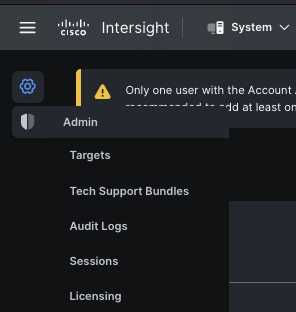
3.1. Haga clic en Reclamar un nuevo destino como se muestra en la imagen.

4. Seleccione Disponible para Reclamación y elija el tipo de destino (por ejemplo, Red) que desea reclamar. Haga clic en Start (Inicio).
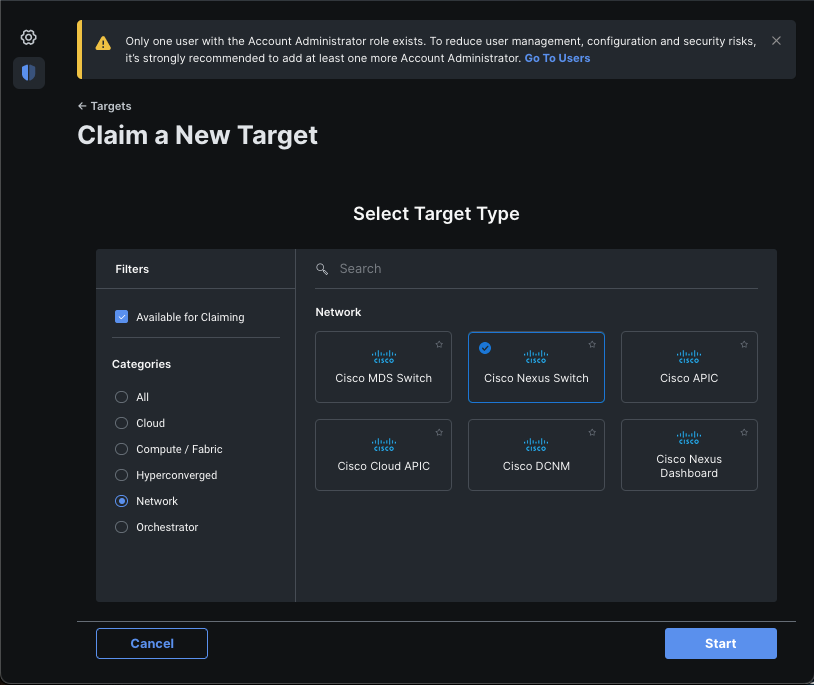
5. Introduzca los detalles necesarios y haga clic en Reclamar para completar el proceso de reclamación.

Nota: El token de seguridad en el switch se utiliza como código de reclamación y el número de serie del switch es el ID de dispositivo.

Nota: El token de seguridad caduca. Debe completar la reclamación antes o el sistema le solicitará que vuelva a generar una.

Reclamación de uno a varios dispositivos Nexus independientes en intersight.com mediante Ansible®
Para reclamar uno o varios dispositivos Nexus, se puede ejecutar un cuaderno Ansible.
- El inventario y el cuaderno de campaña se pueden clonar desde https://github.com/datacenter/ansible-intersight-nxos.
- En el Ansible
inventory.yaml, elansible_connectiontipo se estableceansible.netcommon.network_clien para enviar comandos al switch Nexus. Esto se puede cambiar aansible.netcommon.httpapipara permitir la conectividad a través de NXAPI. - La conexión de Ansible al extremo de Intersight requiere una clave de API, que se puede generar desde su cuenta de intersight.com.
Configuración de Nexus NXAPI (solo se utiliza si se utilizaansible.netcommon.httpapi)

Nota: En el caso de que se configure un proxy de nivel de sistema (HTTP(S)_PROXY) y Ansible no deba utilizar un proxy para conectarse con el extremo Nexus NXAPI, es deseable estableceransible_httpapi_use_proxy: False(el valor predeterminado es True).
# configure terminal
# cfeature nxapi
# nxapi port 80
# no nxapi https port 443
# end
# show nxapi
nxapi enabled
NXAPI timeout 10
NXAPI cmd timeout 300
HTTP Listen on port 80
HTTPS Listen on port 443
Certificate Information:
Issuer: issuer=C = US, ST = CA, L = San Jose, O = Cisco Systems Inc., OU = dcnxos, CN = nxos
Expires: Feb 10 22:30:38 2024 GMT
Para verificar independientemente la conectividad HTTP con el punto final de NXAPI, puede intentar enviar un mensajeshow clock. En el siguiente ejemplo, el switch autentica al cliente mediante la autenticación básica. También es posible configurar el servidor NXAPI para autenticar clientes basados en el certificado de usuario X.509.

Nota: El hash de autenticación básica se obtiene de la codificación base64 de username:password. En este ejemplo, la codificación admin:cisco!123 base64 esYWRtaW46Y2lzY28hMTIz.
curl -v --noproxy '*' \
--location 'http://10.1.1.3:80/ins' \
--header 'Content-Type: application/json' \
--header 'Authorization: Basic YWRtaW46Y2lzY28hMTIz' \
--data '{
"ins_api": {
"version": "1.0",
"type": "cli_show",
"chunk": "0",
"sid": "sid",
"input": "show clock",
"output_format": "json"
}
}'
Respuesta de rizo:
* Trying 10.1.1.3...
* TCP_NODELAY set
* Connected to 10.1.1.3 (10.1.1.3) port 80 (#0)
> POST /ins HTTP/1.1
> Host: 10.1.1.3
> User-Agent: curl/7.61.1
> Accept: */*
> Content-Type: application/json
> Authorization: Basic YWRtaW56Y2lzY28hBNIz
> Content-Length: 297
>
* upload completely sent off: 297 out of 297 bytes
< HTTP/1.1 200 OK
< Server: nginx/1.19.6
< Date: Fri, 09 Feb 2024 23:17:10 GMT
< Content-Type: text/json; charset=UTF-8
< Transfer-Encoding: chunked
< Connection: keep-alive
< Set-Cookie: nxapi_auth=dzqnf:xRYwR0l1Tra64VfOMVuD4oI4=; Secure; HttpOnly;
< anticsrf: /i3vzCvxhOr4w2IrKP+umbDnzHQ=
< Strict-Transport-Security: max-age=31536000; includeSubDomains
< X-Frame-Options: SAMEORIGIN
< X-Content-Type-Options: nosniff
< Content-Security-Policy: block-all-mixed-content; base-uri 'self'; default-src 'self'; script-src 'self' 'nonce-zHx12KP1tervan1s6lrFQz7N6PF0rh'; style-src 'self' 'nonce-zHx12KP1tervan1s6lrFQz7N6P40rh'; img-src 'self'; connect-src 'self'; font-src 'self'; object-src 'self'; media-src 'self'; form-action 'self'; frame-ancestors 'self';
<
{
"ins_api": {
"type": "cli_show",
"version": "1.0",
"sid": "eoc",
"outputs": {
"output": {
"input": "show clock",
"msg": "Success",
"code": "200",
"body": {
"simple_time": "23:17:10.814 UTC Fri Feb 09 2024\n",
"time_source": "NTP"
}
}
}
}
* Connection #0 to host 10.1.1.3 left intact
}%
Generar claves de API de Intersight
Consulte la sección README.md para obtener información sobre cómo obtener la clave de API de laIntersight System > Settings > API keys > Generate API Key.
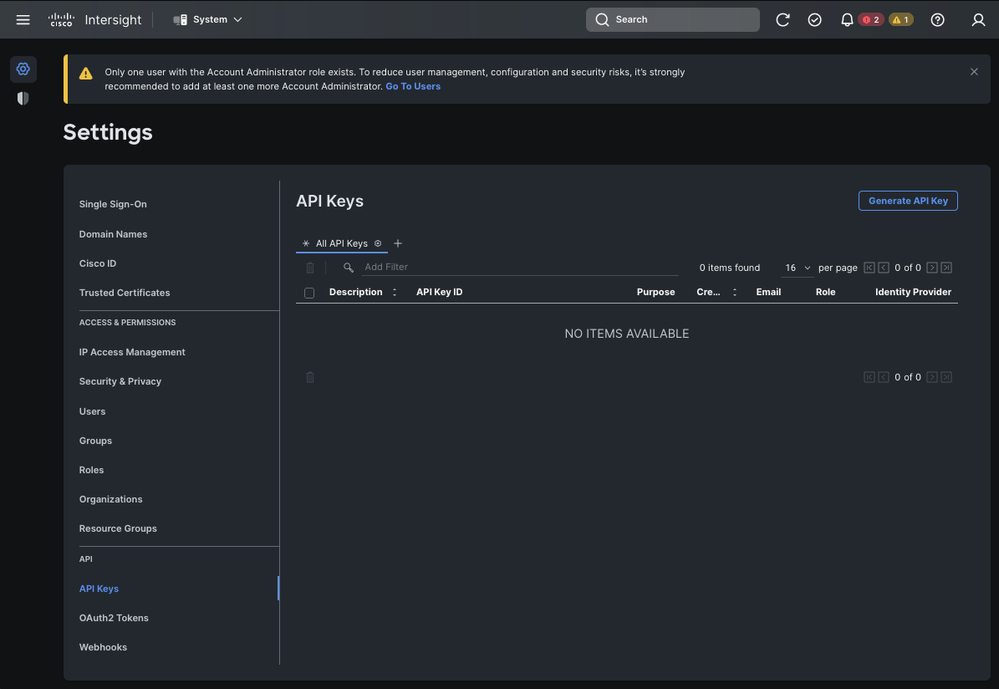
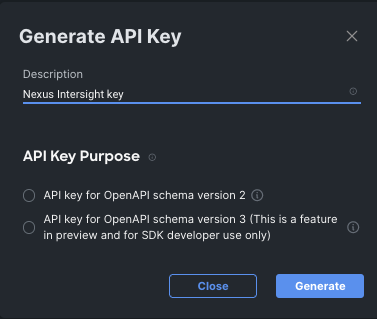
Ejemplo: Ansible inventory.yaml

Nota: En el siguiente ejemplo, ansible se configuró para ignorar la configuración de proxy del sistema operativo conansible_httpapi_use_proxy: False. Si necesita que el servidor Ansible utilice un proxy para alcanzar el switch, puede quitar esa configuración o establecerla en True (valor predeterminado).

Nota: El ID de clave de la API es una cadena de caracteres. La clave privada de la API incluye la ruta de acceso completa a un archivo que contiene la clave privada. Para el entorno de producción, se recomienda utilizar la bóveda Ansible.
---
all:
hosts:
switch1:
ansible_host: "10.1.1.3"
intersight_src: "mgmt0"
intersight_vrf: "management"
vars:
ansible_user: "admin"
ansible_password: "cisco!123"
ansible_connection: ansible.netcommon.network_cli
ansible_network_os: cisco.nxos.nxos
ansible_httpapi_use_proxy: False
remote_tmp: "/bootflash"
proxy_env:
- no_proxy: "10.1.1.3/24"
intersight_proxy_host: 'proxy.cisco.com'
intersight_proxy_port: '80'
api_key_id: "5fcb99d97564612d33fdfcal/5fcb99d97564612d33fdf1b2/65c6c09d756461330198ce7e"
api_private_key: "/home/admin/ansible-intersight-nxos/my_intersight_private_key.txt"
...
Ejemplo:playbook.yamlEjecución
Para obtener más información sobre la programación de dispositivos Nexus independientes con Ansible, consulte laApplications/Using Ansiblesección sobre Cisco NX-OS de la Guía de programación de Cisco Nexus serie 9000 en NX-OS para su versión actual.
❯ ansible-playbook -i inventory.yaml playbook.yaml
PLAY [all] *********************************************************************************************************************************************************
TASK [Enable feature intersight] ***********************************************************************************************************************************
[WARNING]: To ensure idempotency and correct diff the input configuration lines should be similar to how they appear if present in the running configuration on
device
changed: [switch1]
TASK [Configure proxy] *********************************************************************************************************************************************
ok: [switch1]
TASK [Unconfigure proxy] *******************************************************************************************************************************************
skipping: [switch1]
TASK [Configure src interface] *************************************************************************************************************************************
ok: [switch1]
TASK [Unconfigure src interface] ***********************************************************************************************************************************
skipping: [switch1]
TASK [Configure src vrf] *******************************************************************************************************************************************
ok: [switch1]
TASK [Unconfigure src vrf] *****************************************************************************************************************************************
skipping: [switch1]
TASK [Await connection to Intersight] ******************************************************************************************************************************
FAILED - RETRYING: [switch1]: Await connection to Intersight (10 retries left).
FAILED - RETRYING: [switch1]: Await connection to Intersight (9 retries left).
FAILED - RETRYING: [switch1]: Await connection to Intersight (8 retries left).
FAILED - RETRYING: [switch1]: Await connection to Intersight (7 retries left).
FAILED - RETRYING: [switch1]: Await connection to Intersight (6 retries left).
FAILED - RETRYING: [switch1]: Await connection to Intersight (5 retries left).
FAILED - RETRYING: [switch1]: Await connection to Intersight (4 retries left).
ok: [switch1]
TASK [Get show system device-connector claim-info] *****************************************************************************************************************
ok: [switch1]
TASK [Set claiminfoDict] *******************************************************************************************************************************************
ok: [switch1] => (item=SerialNumber: FDO21112E2L)
ok: [switch1] => (item= SecurityToken: 0A70886FE1B8)
ok: [switch1] => (item= Duration: 599)
ok: [switch1] => (item= Message: )
ok: [switch1] => (item= Claim state: Not Claimed)
TASK [claim device - PROXY] ****************************************************************************************************************************************
skipping: [switch1]
TASK [claim device - NO PROXY] *************************************************************************************************************************************
changed: [switch1]
PLAY RECAP *********************************************************************************************************************************************************
switch1 : ok=8 changed=2 unreachable=0 failed=0 skipped=4 rescued=0 ignored=0
Verificación
Para verificar la reclamación de un nuevo destino, realice lo siguiente:
En el switch Nexus
Versiones anteriores a 10.3(4a)M
# run bash sudo cat /mnt/pss/connector.db
Nexus# run bash sudo cat /mnt/pss/connector.db
{
"AccountOwnershipState": "Claimed",
"AccountOwnershipUser": "bpaez@cisco.com",
"AccountOwnershipTime": "2024-04-25T22:37:25.173Z",
"AccountOwnershipId": "TAC-DCRS",
"DomainGroupMoid": "6620503275646133014ec978",
"AccountMoid": "6620503275646133014ec977",
"CloudDns": "svc.ucs-connect.com",
"CloudDnsList": [
"svc.intersight.com",
"svc-static1.intersight.com",
"svc.ucs-connect.com",
"svc-static1.ucs-connect.com"
],
"CloudCert": "",
"UserCloudCerts": {},
"Identity": "662adb256f72613901e8bc19",
"AccessKeyId": "98facfdbf3855bcfd340f2bbb0c388f8",
"AccessKey": "",
"PrivateAccessKey": "-----BEGIN RSA PRIVATE KEY-----
-CUT-
5Do\nD18Ta5YvuIYFLZrYlHLyCDOhS5035AUEGNtEceiPhQjOCvRumyJD\n-----END RSA PRIVATE KEY-----\n",
"CloudEnabled": true,
"ReadOnlyMode": false,
"LocalConfigLockout": false,
"TunneledKVM": false,
"HttpProxy": {
"ProxyHost": "proxy.cisco.com",
"ProxyPort": 8080,
"Preference": 0,
"ProxyType": "Manual",
"Targets": [
{
"ProxyHost": "proxy.cisco.com",
"ProxyPort": 8080,
"Preference": 0
}
]
},
"LogLevel": "info",
"DbVersion": 1,
"AutoUpgradeAdminState": "Automatic"Versiones que comienzan con 10.3(4a)M
# show system device-connector claim-info
N9k-Leaf-2# show system device-connector claim-info
SerialNumber: FDO23021ZUJ
SecurityToken:
Duration: 0
Message: Cannot fetch claim code for already claimed device
Claim state: Claimed
Claim time: 2024-02-09T15:38:57.561Z
Claimed by: brvarney@cisco.com
Account: ACI-DCRS-TAC
Site name:
Site ID:# show system internal intersight info
# show system internal intersight info
Intersight connector.db Info:
ConnectionState :Connected
ConnectionStateQual :
AccountOwnershipState :Claimed
AccountOwnershipUser :brvarney@cisco.com
AccountOwnershipTime :2024-02-09T15:38:57.561Z
AccountOwnershipId :ACI-DCRS-TAC
DomainGroupMoid :5eb2e1e47565612d3079fe9a
AccountMoid :5eb2e1e47565612d3079fe92
CloudDns :svc.ucs-connect.com
CloudDnsList:
1. :svc.ucs-connect.com
2. :svc.intersight.com
3. :svc-static1.intersight.com
4. :svc-static1.ucs-connect.com
Identity :65c647116f72513501e75530
CloudEnabled :true
ReadOnlyMode :false
LocalConfigLockout :false
TunneledKVM :false
HttpProxy:
ProxyHost :proxy.cisco.com
ProxyPort :8080
Preferenc :0
ProxyType :Manual
Target[1]:
ProxyHost :proxy.cisco.com
ProxyPort :8080
Preference :0
LogLevel :info
DbVersion :1
AutoUpgradeAdminState :Automatic
Ansible
Es posible agregar una tarea al final delplaybook.yamlpara obtener la información de la intercepción del switch.
- name: Get intersight info
nxos_command:
commands:
- show system internal intersight info
register: intersightInfo_claimed
retries: 10
delay: 10
until: intersightInfo.stdout is search("Connecte")
- name: Display intersight info
vars:
msg: |-
output from {{ inventory_hostname }}:
{{ intersightInfo_claimed.stdout | join("") }}
debug:
msg: "{{ msg.split('\n') }}"
Este es el resultado correspondiente:
TASK [Get intersight info] ***************************************************************************************************
ok: [switch1]
TASK [Display intersight info] ***********************************************************************************************
ok: [switch1] => {
"msg": [
"output from switch1:",
"Intersight connector.db Info:",
"ConnectionState :Connected",
"ConnectionStateQual :",
"AccountOwnershipState :Claimed",
"AccountOwnershipUser :vricci@cisco.com",
"AccountOwnershipTime :2024-02-10T01:00:28.516Z",
"AccountOwnershipId :vricci",
"DomainGroupMoid :5fcb98d97565612d33fdf1ae",
"AccountMoid :5fcb98d97565612d33fdf1ac",
"CloudDns :svc.intersight.com",
"CloudDnsList: ",
" 1. :svc.intersight.com",
" 2. :svc-static1.intersight.com",
" 3. :svc.ucs-connect.com",
" 4. :svc-static1.ucs-connect.com",
"Identity :65c6caac6f72613901f841c1",
"CloudEnabled :true",
"ReadOnlyMode :false",
"LocalConfigLockout :false",
"TunneledKVM :false",
"HttpProxy: ",
" ProxyHost :proxy.cisco.com",
" ProxyPort :80",
" Preferenc :0",
" ProxyType :Manual",
" Target[1]: ",
" ProxyHost :proxy.cisco.com",
" ProxyPort :80",
" Preference :0",
"LogLevel :info",
"DbVersion :1",
"AutoUpgradeAdminState :Automatic"
]
}
Desactivar el conector de dispositivo
| Comando o acción | Propósito | |
|---|---|---|
| Paso 1 |
no feature intersight Ejemplo: switch(config)# no feature intersight |
Inhabilita el proceso de intersight y elimina toda la configuración de NXDC y el almacén de registros. |
Historial de revisiones
| Revisión | Fecha de publicación | Comentarios |
|---|---|---|
4.0 |
30-Sep-2024 |
Se ha añadido el aviso de la región EMEA a la sección "Configurar - En el portal de intercambio" |
3.0 |
15-May-2024 |
Añadido vídeo de inicio rápido para reclamar manualmente su dispositivo NXOS |
2.0 |
02-Apr-2024 |
Se ha añadido la sección "Desactivar el conector del dispositivo" |
1.0 |
22-Feb-2024 |
Versión inicial |
Con la colaboración de ingenieros de Cisco
- Branden VarneyTechnical Leader
- Vincent RicciTechnical Leader
- Yogesh RamdossPrincipal Engineer
Contacte a Cisco
- Abrir un caso de soporte

- (Requiere un Cisco Service Contract)
 Comentarios
Comentarios